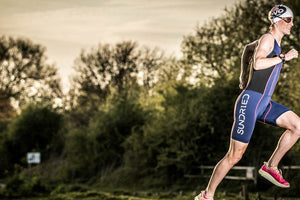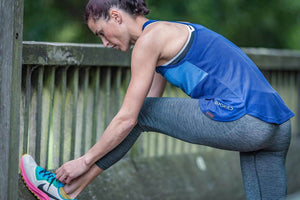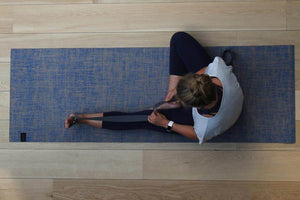Get ready to swap your swimsuit for skis when you sign up for a Winter Triathlon…
Many triathletes use the winter period to dial down their training regimes and take a well-earned rest. But that doesn’t mean the world of triathlon goes into hibernation. While the swim-bike-run tribe starts to put its collective feet up, another triathlon season is just beginning…
What is Winter Triathlon?
Winter Triathlon involves running, mountain biking and cross-country skiing across snow-covered terrain. Sanctioned by the International Triathlon Union - who are lobbying hard to get this gruelling endurance race included in the upcoming winter Olympic games - the sport first emerged in the 1980s, although it didn’t really take off until the 1990s when it was recognised by the ITU. The first ITU Winter Triathlon World Championship took place in Italy in 1997, and they have been held annually ever since, now attracting thousands of Elite, U23, Para, Mixed Relay and Age Group athletes every year from across the globe. Extremely popular in Europe, the US and Canada, the sport is gaining traction in the UK with people who have an appetite for adventure and are willing to travel to events held on the snow-topped mountains of the Northern Hemisphere.
As with traditional triathlon events, race distances vary. Short, intermediate, long, and ultra versions are all available to enter, but a typical winter triathlon consists of a 5-9k run, 10-15k mountain bike, and 8-12k cross-country ski. Courses are designed so that it should take the winner of the elite men’s race about 80-90 minutes to complete, and distances are set on the day of a race to take the latest snow conditions into account; you may well wake up to find a foot of the white stuff has fallen overnight, but this only adds to the excitement and unpredictability of the sport as you tackle the various surfaces and challenges thrown your way.

What kit do I need?
If you’re feeling inspired to start competing in more adverse climatic conditions, you’ll need to invest in some specialised equipment and kit suitable for snowy, slippery terrain and colder temperatures.
Running: For starters, it’s difficult to run across the snow in normal running shoes. Because the running leg is contested on hard-packed snow, many winter triathletes wear cross-country spikes for extra traction, although trail shoes can work and are often used in competition (in some races, snowshoes are the norm). Whatever you choose, you’ll need a relatively supportive shoe to avoid injury as the footing on snow can be challenging. One tip is to follow in the footsteps of a runner ahead of you.
Mountain biking: Competitors ride standard racing mountain bikes, but they’re generally equipped with relatively wide tyres featuring an aggressive tread (2.2 to 2.4 inches is recommended), because staying upright on your bike in the snow requires more balance and traction than usual. While tyres with spikes are legal, most competitors shun them due to their additional weight. You’ll also need to run your tyres at a relatively low pressure (about 15-20 psi), otherwise your bike might be impossible to ride in the snow. Finally, helmets are mandatory, but be aware that heavy snow fall could mean pushing your bike is faster than attempting to ride it!
Cross-country skiing: Also known as ‘langlauf’, the cross-country skiing leg usually takes place on groomed Nordic ski trails. Both classic and freestyle (skating) techniques are allowed, although most serious competitors use the freestyle technique as it’s faster. You’ll need a supportive ski boot, poles and cross-country skis, and you’ll need to prep your skis with waxing for success. Remember, many Nordic skiing areas offer rental if you want to try the sport before you buy.
Staying warm: Invest in cold weather-specific technical clothing such as base layers, tights, socks, gloves, and hats to keep your body and extremities warm, and choose clothing with reflective details to help you be seen while training in low light conditions. You may well need an insulating top for the mountain biking leg as your upper half will remain mostly static throughout.

How do I train for a winter triathlon?
Due to the colder temperatures and extreme terrain, you should only sign up for a winter triathlon if you have experience of competing in a regular triathlon, mainly to ensure you have a good base level of fitness, experience of transitions, and knowledge of how to stay properly fuelled and hydrated (dehydration is a major health hazard in winter triathlon). And of course, having experience of long-distance running and cycling will certainly be advantageous.
Running across compacted snow isn’t that different to running on hard ground, but it’s worth practicing a relatively high turnover using a midfoot to forefoot strike (as opposed to taking long strides), because overstriding can cause you to punch into the snow.
A tip for your mountain bike training is to ride on sandy surfaces to mimic the huge resistance of the snow, using an easy gear while riding at a high cadence (faster pedal rate); this will ultimately improve your efficiency, work your cardio system more to save strength, and help you manage fatigue before the cross-country skiing leg.
According to ITU representative Eric Angstadt, the technique and demand of Nordic skiing ‘is one of the highest in elite sport’, but it will be your finesse - rather than your fitness - that will be key to skiing fast. Therefore, it is absolutely recommended that you learn to balance and efficiently propel yourself forwards on cross-country skis before entering a competition. If you can attend training sessions at a Nordic skiing centre, fantastic. If not, and you live in the UK, you can prepare by signing up for a Rollerski course which involves cross-country skiing without the snow.
As with regular triathlon training, preparing for a winter triathlon takes commitment and a well-structured training plan so you can put your new skills into practice and improve your strength and cardio endurance. But putting in this effort - at a time when you might normally take things easy - means you will improve your base fitness (which could pay off handsomely come the spring), and experience some spectacular scenery and magical, snowy landscapes along the way.
Would you give a winter triathlon a go? Let us know your thoughts below!





















